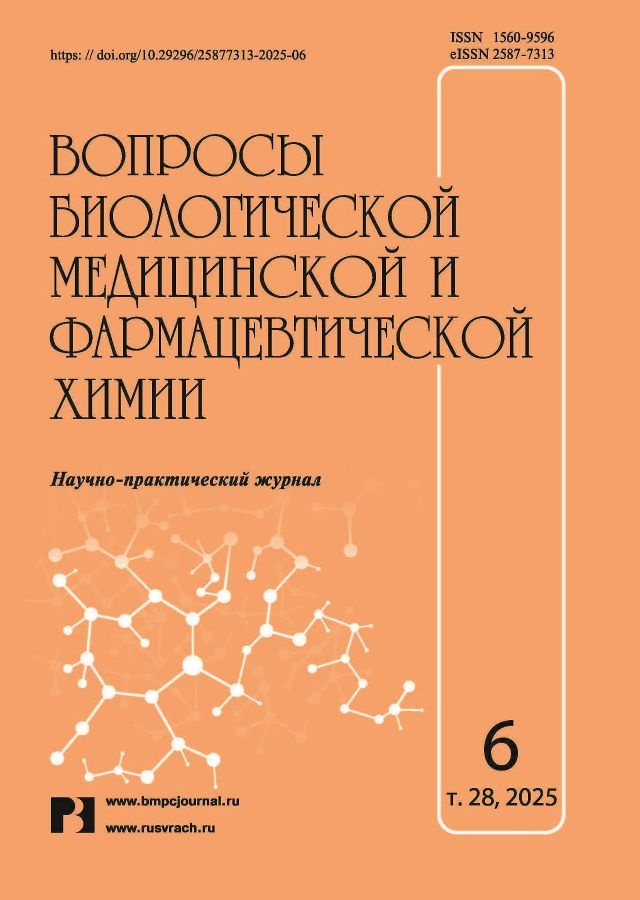Разработка спектрофотометрической и титриметрической методик количественного определения водорастворимого антиоксиданта 3-(4-гидрокси-3,5-диметилбензилтио)пропионата калия (ТФ-7)
- Авторы: Мукундви В.Т.1, Терентьева С.В.1,2, Лигостаев А.В.1, Ивановская Е.А.1, Кандалинцева Н.В.2, Олейник А.С.2
-
Учреждения:
- ФГБОУ ВО «Новосибирский государственный медицинский университет» Минздрава России
- ФГБОУ ВО «Новосибирский государственный педагогический университет»
- Выпуск: Том 28, № 6 (2025)
- Страницы: 99-108
- Раздел: Фармацевтическая химия
- URL: https://journals.eco-vector.com/1560-9596/article/view/685731
- DOI: https://doi.org/10.29296/25877313-2025-06-13
- ID: 685731
Цитировать
Полный текст
Аннотация
Введение: Синтез и изучение специфической активности органических соединений на основе серы – одно из перспективных направлений развития химии антиоксидантов. Наиболее активные изыскания в этой области выполняются на кафедре химии ФГБУ ВО «Новосибирский государственный педагогический университет» совместно с НИИ химии антиоксидантов.
Цель исследования – изучение спектрофотометрических и титриметрических характеристик серосодержащего водорастворимого антиоксиданта (3-(4-гидрокси-3,5-диметилбензилтио)пропионата калия) и их сравнение.
Материал и методы Рассмотрены спектрофотометрические характеристики новой фармацевтической субстанции водорастворимого антиоксиданта 3-(4-гидрокси-3,5-диметилбензилтио)пропионата калия (TФ-7). Метод спектрофотометрии применяли для количественного и качественного определения. Для сравнительного анализа новой субстанции ТФ-7 определяли условия титриметрических методов: ацидиметрии, йодометрии и меркуриметрии.
Результаты. Предварительные исследования показали, что спектрофотометрический анализ 3-(4-гидрокси-3,5-диметил-бензилтио)пропионата калия в УФ-спектре имел максимум при длине волны 276±2 нм. Метод меркуриметрии оказался наиболее точным из подобранных титриметрических методов для определения ТФ-7, с уравнением y=1,014895x+0,0000001, коэффициент корреляции 0,9996.
Выводы. Определены условия спектрофотометрического и титриметрических методов анализа для количественной оценки новой субстанции ТФ-7. Показано, что разработанные методики получения качественных и количественных характеристик для спектрофотометрического определения и меркуриметрического титрования являются оптимальными для анализа в модельных растворах.
Ключевые слова
Полный текст
Об авторах
В. Т. Мукундви
ФГБОУ ВО «Новосибирский государственный медицинский университет» Минздрава России
Автор, ответственный за переписку.
Email: willardmkundwi@gmail.com
ORCID iD: 0009-0005-6654-7185
аспирант, кафедра фармацевтической химии
Россия, 630091, г. Новосибирск, Красный проспект, 52С. В. Терентьева
ФГБОУ ВО «Новосибирский государственный медицинский университет» Минздрава России; ФГБОУ ВО «Новосибирский государственный педагогический университет»
Email: willardmkundwi@gmail.com
ORCID iD: 0000-0003-3566-2760
SPIN-код: 6439-9850
д.фарм.н., профессор кафедры фармацевтической химии; профессор кафедры химии
Россия, 630091, г. Новосибирск, Красный проспект, 52; 630126, г. Новосибирск, ул. Вилюйская, 28А. В. Лигостаев
ФГБОУ ВО «Новосибирский государственный медицинский университет» Минздрава России
Email: willardmkundwi@gmail.com
ORCID iD: 0009-0002-0317-6944
к.фарм.н., доцент кафедры фармацевтической химии
Россия, 630091, г. Новосибирск, Красный проспект, 52Е. А. Ивановская
ФГБОУ ВО «Новосибирский государственный медицинский университет» Минздрава России
Email: willardmkundwi@gmail.com
ORCID iD: 0000-0002-9338-5792
д.фарм.н, профессор, зав. кафедрой фармацевтической химии
Н. В. Кандалинцева
ФГБОУ ВО «Новосибирский государственный педагогический университет»
Email: willardmkundwi@gmail.com
ORCID iD: 0000-0001-6022-934X
SPIN-код: 9814-7106
д.х.н., доцент, зав. кафедрой химии
Россия, 630126, г. Новосибирск, ул. Вилюйская, 28А. С. Олейник
ФГБОУ ВО «Новосибирский государственный педагогический университет»
Email: willardmkundwi@gmail.com
ORCID iD: 0009-0007-1113-6682
SPIN-код: 8988-3870
к.х.н., доцент кафедры химии
Россия, 630126, г. Новосибирск, ул. Вилюйская, 28Список литературы
- Адельшина Е.Б., Просенко О.И., Кандалинцева Н.В. Александр Евгеньевич Просенко: Научное Наследие. Свободные радикалы и антиоксиданты в химии, биологии и медицине Материалы всероссийской конференции с международным участием, посвященной 75-й годовщине со дня рождения профессора Александра Евгеньевича Просенког. Новосибирск. 2022.
- Meier H., Kuenzi H., Knobloch G., et al. Reactions of Sulfur Containing Phenolic Antioxidants for Elastomers. Phospho-rus, Sulfur, and Silicon and the Related Elements. 1999; 153(1): 275–300; https://doi.org/10.1080/10426509908546440.
- Ahmad M.H., Rahman N.A., Kadir F.A. et al. Design and synthesis of sulfur-containing butylated hydroxytoluene: antioxidant potency and selective anticancer agent. J Chem Sci. 2019; 131: 107p; https://doi.org/10.1007/s12039-019-1682-x.
- Damiano Tanini, Veronica D'Esopo, Dan Chen et al. Novel sulfur and selenium-containing antioxidants: Synthesis and evaluationof their GPx-like activity. Phosphorus, Sulfur, and Silicon and the Related Elements. 2017; 192(2): 166–168. doi: 10.1080/10426507.2016.1252365.
- Кандалинцева Н.В. Полифункциональные водорастворимые антиоксиданты фенольного типа. Окисление, окислительный стресс, антиоксиданты: Доклады и тезисы Всеросс. конф. молодых ученых и VII школа им. акад. Н.М. Эмануэля. М.: РУДН. 2015: 81–101.
- Меньщикова Е.Б., Ланкин В.З., Кандалинцева Н.В. Фенольные антиоксиданты в биологии и медицине. Saarbrücken. 2012; 488 с.
- Олейник А.С., Куприна Т.С., Певнева Н.Ю. и др. Синтез и антиоксидантные свойства S-(3-(гидроксиарил)пропил)тиосульфатов и (3-(гидроксиарил)пропан)-1-сульфо-натов натрия. Изв. АН. Сер. хим. 2007; 6: 1094–1101.
- Sirotenko A.A. Titrimetric microdetermination of sulfur in compounds containing alkali or alkaline earth. Mikrochim Acta. 1955; 43: 153–154; https://doi.org/10.1007/BF01220665.
- Tiwari K.K., Verma R.M. Titrimetric microdetermination of certain sulphur-containing organic compounds by oxidation with alkaline potassium permanganate. Talanta. 1983; 30(6): 440–442. doi: 10.1016/0039-9140(83)80103-9.
- Tiwari K.K., Verma R.M. Titrimetric determination of certain mercaptans with mercuric chloride. Talanta. 1981; 28(6): 397–398. doi: 10.1016/0039-9140(81)80192-0.
- Pelosi C., Quaranta A., Rollo M. et al. Preparation and Characterization of Zinc(II)-Based Lewis/Brønsted Acidic Deep Eutectic Solvents. Molecules 2023, 28, 8054; https://doi.org/10.3390/molecules28248054.
- Eiji Hayashi, Yukio Takahashi, Hironori Itoh, Norihiko Yoneda. Enhancement of Catalytic Activity of ZnCl2 in the Friedel–Crafts Benzylation of Benzenes Using Polar Solvents, Bulletin of the Chemical Society of Japan. 1993; 66(Issue 11): 3520–3521; https://doi.org/10.1246/bcsj.66.3520.
- Государственная фармакопея Российской Федерации. XV издания. URL: https://pharmacopoeia.regmed.ru/pharmaco-poeia/izdanie-15.
- Беликов В.Г. Фармацевтическая химия: учебное пособие в 2 частях, 5-е изд. Учебное пособие. М.: МЕДпресс-информ. 2021; 616 c.
- Мукундви В.T., Ивановская Е.А., Лигостаев А.В. Разработка методики количественного определения субстанции гидрофильного антиоксиданта TФ-7 методом инверсионной вольтамперометрии. Journal of Siberian Medical Sciences. 2024; 8(2): 80–89. doi: 10.31549/2542-1174-2024-8-2-80-89.
- European Pharmacopoeia 8th Edition-2022 Technical Guide For The Elaboration Of Monographs.
- ГОСТ Р 8.600-2003. Государственная система обеспечения единства измерений. Методики выполнения измерений массовой доли основного вещества реактивов и особо чистых веществ титриметрическими методами.
- EURAMET Calibration Guide No. 21, version 2.0(05/2020).
Дополнительные файлы















